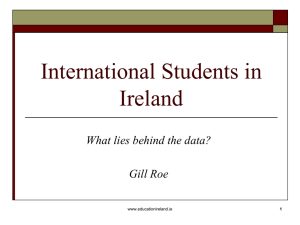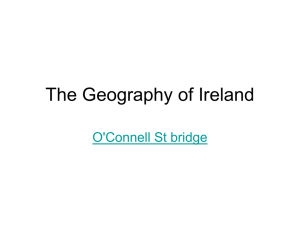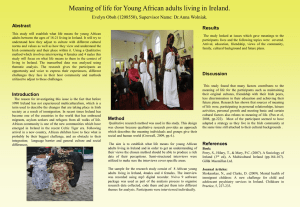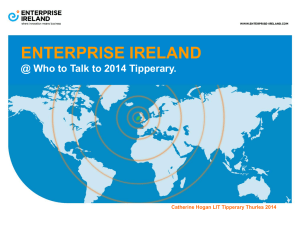Introducing the issues and presenting case studies
advertisement
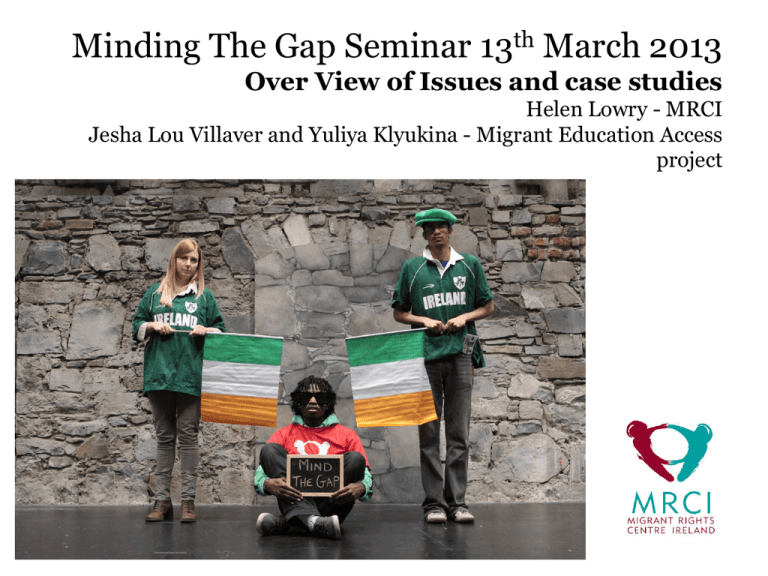
Minding The Gap Seminar 13th March 2013 Over View of Issues and case studies Helen Lowry - MRCI Jesha Lou Villaver and Yuliya Klyukina - Migrant Education Access project Ireland today and the 1.5 generation Ireland as a diverse multicultural country 17% of population born outside of Ireland (2011 Census) Ireland’s youth population diverse 1 in 7 children migrant background estimated 22,681 children born outside the EU registered in Irish secondary schools (2011, Dept of Education) Ireland at a particular point in our immigration (inwards migration) history 15 years on from first significant experience of inwards migration Who are the 1.5 generation Children of Non EU migrants not born in Ireland or the EU but resident in Ireland for a minimum of 5 years, have made Ireland home Went to secondary school in Ireland in some cases primary school Motivation - came to Ireland to reunite with parents and family members Understanding the problem The Irish Immigration system Absence of coherent framework of immigration law over the past decade In addition policies not constructed to deal with needs and realities of child dependents joining non EU migrant parents Registration at 16 – lack of status beforehand Residency stamps inappropriate and ineligible Lack of pathways to permanency and citizenship for children of Non EU migrants Welcome developments by Department of Justice and Equality but essentially interim measures leaving some young people to fall between gaps Understanding the problem Progressing to third level education Interim and adhoc responses by third level institutes over past decade have become policy e.g. ‘EU fees’ ‘EU fees’ whilst less than international student fees still amount to on average €7000 for a typical 3 year degree in an Irish university Lack of access to financial assistance primarily due to nationality criteria for free fees initiative and higher education grants Inability to reverse fee status upon securing citizenship mid third level education Jesha Lou & Yuliya’s story Impact on young people and their families • Stress, anxiety and worry • Financial pressure, debt, disposable income drained, at greater risk of poverty • Young people not taking up their CAO offer to save money for fees and/or wait until naturalised • Going to collage not an option – a lost generation? • Making difficult choices between siblings, courses, returning to home country Numbers effected • A lack of clear data but not as many as you would think – Faster naturalisation procedures – Introduction of new measures to facilitate naturalisation process for children dependents in • 2,192 Non EEA between the ages of 16 and 18 currently registered with the GNIB (PQ 2013) • = approximately 730 students per year of the leaving cert cycle • Many will secure citizenship, not all will choose to go to third level education Cost/benefit argument Cost to the state Benefits • Short term cost • Unemployment rates for 3rd level graduate lower by over 50% • 3rd level graduates earn more = higher wages = higher consumer spending power = higher tax contribution = better for the economy 12,690 invested by state per student X 613 (84% entry rate) _________________ = Approx €7 million Rationale for Minding the Gap • Short term cost to the Department of Education will save the state a fortune in the longer term i.e. cant afford not to do something • Numbers impacted can be dealt with prior to forthcoming Immigration Bill • Investment in Ireland’s future – Knowledge economy subjects – Bright, ambitious young people and their contribution – Particular insights and experiences the 1.5 generation bring (dual identities, intercultural understanding) • Equality, social inclusion, social cohesion arguments – setting the standards for future generations




